|
|
| Spot |
| Tatsumi Shrine | 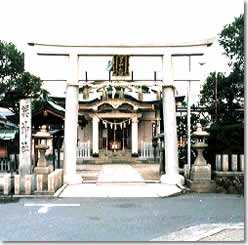 |
| Location: 3-17-19 Tajima-Minami, Ikuno-ku | |
| Access: 1 minute walk to the southeast from subway Minami Tatsumi Station | |
| The deity of the Tatsumi Shrine is the
15th Emperor Ojin. It was known as the Hachiman Shrine in Oji Village
(the old name of Tatsumi) in Kawachi Province. Although the date of
the erection of this shrine is unknown, the village name of Oji or
Ochi appears in Wamyo Ruijusho (a 10th century dictionary) and in
10th century literature along with the names of neighboring villages.
It seems that the shrine has been the abode of the tutelary deity
from olden times. In 1907, the deities of five neighboring shrines were enshrined together and the shrine was renamed Tatsumi (the new village's name). |
| Kiyomihara Shrine | 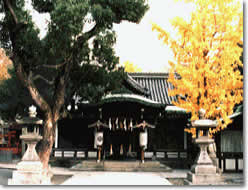 |
| Location: 2-24-35 Shoji, Ikuno-ku | |
| Access: 5 minutes walk to the southeast from subway Shoji Station | |
| The Kiyomihara Shrine is
dedicated to Emperor Tenmu (673 - 686), the 40th emperor. The date
of erection is unknown. It is said that Emperor Tenmu stayed for a
while in Ootomo Village (old name of Shoji) during his visit to Naniwa
(ancient Osaka) and that the shrine was built to commemorate the imperial
visit. In 1909, five other shrines in the neighborhood were consolidated into this shrine, which was renamed the Shoji Shrine after the village name. In 1942, the shrine was rebuilt in commemoration of the 2,600th anniversary of the accession of the first Emperor Jinmu, and the old name of Kiyomihara was restored. |
| Naniwa-ji Temple | 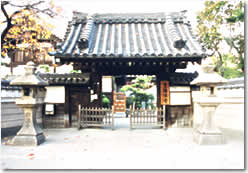 |
| Location: 1-7-18 Tatsumi-Kita, Ikuno-ku | |
| Access: Bus station Tatsumi-Kita 1 | |
| Naniwa-ji is the 13th amulet-issuing
temple of the Osaka Kannon pilgrimage (through Osaka to 33 Kannon
(Goddess of Mercy) temples). The principal image is the eleven-faced
Kannon, which was supposedly erected and worshipped by Kagekiyo, a
great warlord of the Taira clan in the 12th century. The temple was
in Higashi Kozu and had been known as the Kannon of Nonaka (the old
name of the city) until 1924 when it was relocated to this site. At the west entrance is a stone image of Jizo, which people say was sculpted by Kobo Taishi, a famous priest of the 9th century. It is called Sumikake Jizo-san (the ink-smeared Jizo) because people smear the image with black ink, praying for proficiency in calligraphy (which was one of the many attributes of Kobo Taishi). |
| Sharidera Sonsho-ji Temple | 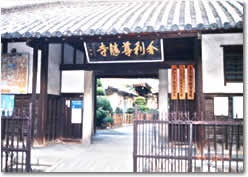 |
| Location: 1-2-36 Sharidera, Ikuno-ku | |
| Access: 5 minutes walk to the west from the bus station Ikuno Fire Station | |
| This is a Zen sect temple.
The principal image is Sakyamuni (Buddha). According to legend, this temple was built about 1400 years ago. In the reign of Emperor Yomei, there was a rich man in Ikuno who had a deaf-mute child. The rich man implored Prince Shotoku (574 - 622) to restore the child's speech. The prince said to the child, "Give me back the three urns of the Buddha's ashes that I entrusted to you in my previous incarnation." The child discharged the three small urns from its mouth and became able to talk. Prince Shotoku consigned one urn to Horyu-ji Temple in Nara, one to Shitenno-ji Temple in Osaka and the remaining one to the rich man. He built this temple to keep the Buddha's ashes. |
| Entoku-ji Temple | 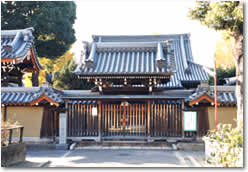 |
| Location: 4-8-26 Tatsumi-Naka, Ikuno-ku | |
| Access: 3 minutes walk to the west from subway Minami Tatsumi Station | |
| According to old chronicles,
this temple was built in 1488 by one Ueba Matasaburo Masayoshi, who
was a samurai under the Shogun Ashikaga Yoshihisa (1473 - 1489) and
later became a priest and disciple of Abbot Rennyo (1415 - 1499) of
Hongan-ji. This temple keeps the death register and a set of furniture of Wankyu, a wealthy merchant in Osaka, whose history was written by the famous Ihara Saikaku (1642 - 1693). |